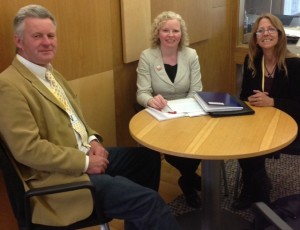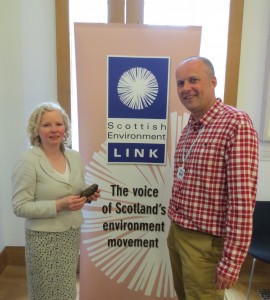Today in the Chamber I opened for Labour during the Committee Debate on the Scottish Government’s draft Second Report on Proposals and Policies (RPP2). RPP2 is the document that lays out what action the Scottish Government will be taking in the years ahead to reach our legally binding emission reduction targets.
Unfortunately we have an early indication that all is not well. The Government’s first emissions target was missed and we have yet to see the greater action needed to get back on track.
Stop Climate Chaos have completed a scenario calculation which shows that only if the EU shifts to 30%, and all policies and proposals were introduced, would Scotland hit all targets. With it looking likely that any change to the EU target won’t be delivered until at least 2016, RPP2 is at risk of being doomed to failure.
Failure to achieve the targets in the early years will only make future targets more difficult to achieve as we will be constantly compensating rather than making progress.
It’s not just concerns over the EU target and the impact that will have – it is also the over reliance on proposals over policies. While proposals have a role to play, the dominance of proposals risks undermining the credibility of the document
Of course there needs to be a degree of flexibility but an over reliance on proposals leads to the plan lacking credibility. As opposed to proposals, policies come along with finance and/or legislation as well as clear timescales. It’s not clear which proposals are expected to become policy.
A copy of my speech is available below and a video will be added once it becomes available:
Thank you Presiding Officer
I welcome the debate this afternoon. The Climate Change (Scotland) Act is a significant piece of legislation – it established Scotland as a good example of Government and Parliamentary action on climate change and it set out ambitious targets which we all agreed to. It was recognised internationally as progressive. In a number of recent debates, we have made clear that the rewards of delivery are not just domestic but also contribute towards Scotland’s effort in delivering climate justice and our international obligations. The collective international effort is not where it needs to be and increasingly there is not only a greater need for leadership but also results. There is a huge responsibility on this Parliament and the Government to deliver.
We all accept Scotland’s targets are ambitious but that places all the more emphasis on the need to deliver if the targets are to be credible. We have had early indication that all is not well. The first emissions target was missed – the Minister blamed a cold winter – surely that shouldn’t really be a surprise in Scotland. But we need to move away from these excuses and what we need to see is greater action – cold winters by themselves are not the problem – too many homes and properties with inadequate insulation and inefficient heating, not enough progress on building standards for new homes – we can’t afford missed opportunities if we are to deliver the step changed needed. Also, much of the progress which has been made can be attributed to the economic downturn – there are concerns that not enough is being done now to embed change.
This afternoon we are debating a draft report and the next few weeks provides the Scottish Government with the opportunity to respond to the concerns raised and come back with a more convincing set of policies and proposals.
In this short debate it is impossible to cover the four reports, and the convenors opening comments set out the thrust of each of the reports. While there has been scrutiny by policy area, there is a need for scrutiny of RPP2 as a coherent package of measures – although RACCE is the lead committee, there was no synergies between the reports – I know there was frustration from witness at RACCE that they couldn’t talk about transport policy, though it’s pretty impossible to talk about behavioural change without it. But through the hours of scrutiny, by MSPs, by environment campaigners, local authorities, key stakeholders and partners, there are key messages emerging which the Government must listen to and act on.
Although it is a statutory requirement to report on how the Scottish Government will respond to the missing target – it is open to interpretation whether or not it achieves this. There is rhetoric but it is difficult to identify what specific policies or proposals have changed in response to the missed target. There has been criticism that it is difficult to compare RPP1 and RRP2. There is a lack of transparency over which proposals from RPP1 have become policies, what proposals and policies have been dropped and how many have been delayed. The Economy committee make the point that there needs to be clearer explanation of what steps will be taken to address the failings of RPP1 – if anything there have been comments that there is less detail in RPP2 rather than more.
No one would suggest that meeting our climate change targets would be easy. It needs a combination of Government effort, local authorities, individuals and communities and the reports make good points in these areas. There is an acknowledgment that there are positives in the document – that’s not in doubt. The recognition of the importance of peatlands restoration is a welcome addition to the Government’s priorities. We can point to progress in recycling. As part of behaviour change, our schools and their partners are doing a lot of good work, and as my local primary school heading off to the beach today as part of Eco Week, I don’t imagine they expected to be doing that in the snow, but the unpredictability of our weather at home and abroad is one of the key challenges of climate change.
However the question is whether RPP2 is robust enough to get us where we need to be. Whether the document is credible, ambitious, transparent and capable of delivery? When the document was published, Stop Climate Chaos did a scenario calculation demonstrating that only if the EU shifts to 30%, and all policies and proposals were introduced, would Scotland hit all targets. With it looking likely that any change to the EU target won’t be delivered until at least 2016, RPP2 is at risk of being doomed to failure. Failure to achieve targets in the early years will only make future targets more difficult to achieve – we will be constantly compensating rather than making progress. Stop Climate Chaos chair Tom Ballantine has in recent days described it as
‘Ministers are trying to pull the wool over the eyes of the parliament with the current climate plan.’
To be fair to the committees, they have recognised the risk. RACCE’s report states:
‘It is clear from the draft Second Report on Proposals and Polices that there is only one combination of circumstances that will allow Scotland to meet each of its annual targets from 2013 until 2027.’
The committees are consistent in calling for the Scottish Government to be clear about how they will respond to a delay or failure of the EU to set a 30% target – at the weekend a Government spokeswomen is reported as saying it was ‘commonly understood’ that Scottish targets were based on the EU target. That is not the case – it was always recognised that without the 30%, achieving targets would be harder, but they were there to be achieved regardless of the EU target. The challenge for Scotland is to be bold and ambitious in this context – and RPP2 needs to respond to these challenges.
It’s not just concerns over the EU target and the impact that will have – it is also the over reliance on proposals over policies. While proposals have a role to play, the dominance of proposals risks undermining the credibility of the document - RACCE describe it as a failure to ‘strike the appropriate balance between policies and proposals’. RPP2 itself recognises it limitations – as Stop Climate Chaos highlight – low carbon transport policies are classified as proposals rather than policies and RPP2 states
‘…while in most cases they are already being taken forward, they are not being implemented at the intensity required for the abatement figures in the document.’
Of course there needs to be a degree of flexibility but an over reliance on proposals leads to the plan lacking credibility. As opposed to proposals, policies come along with finance and/or legislation as well as clear timescales. It’s not clear which proposals are expected to become policy.
In 2009 as the Climate Change Act was passed, there was recognition of the need for ‘early action’. Yet RPP2 backloads activity and there is a lack of evidence of policy action in the earlier years of the intensity needed. Transport, housing and rural land use are the areas identified for additional effort – that is not to say nothing is happening but that the scale of the challenge in these areas are significant, and we have the opportunity to do more about them now.
And while there are calls for a greater commitment in the early years, there were particular concerns raised over the future abatement figures. ‘Wishful thinking’ was used in more than one committee. From 2025, Transport and Rural Land Use in particular identify significant abatement to potentials. The Infrastructure committee state that they are
‘concerned that it is unclear as to how these abatement figures have been calculated.’
There needs to be greater transparency over how projections are arrived at if there is to be confidence in the document.
The Minister cannot deliver on these challenges alone. It needs a Government response; and it needs leadership in Cabinet if the RPP2 is to have the confidence of MSPs and wider Scotland. While there is support for what can be achieved, the purpose of RPP2 is to set out the future path to meet the statutory targets and there are concerns that the report, as it stands, will fail to achieve these. Scotland has a reputation on climate change that it world leading and is worth saving.


